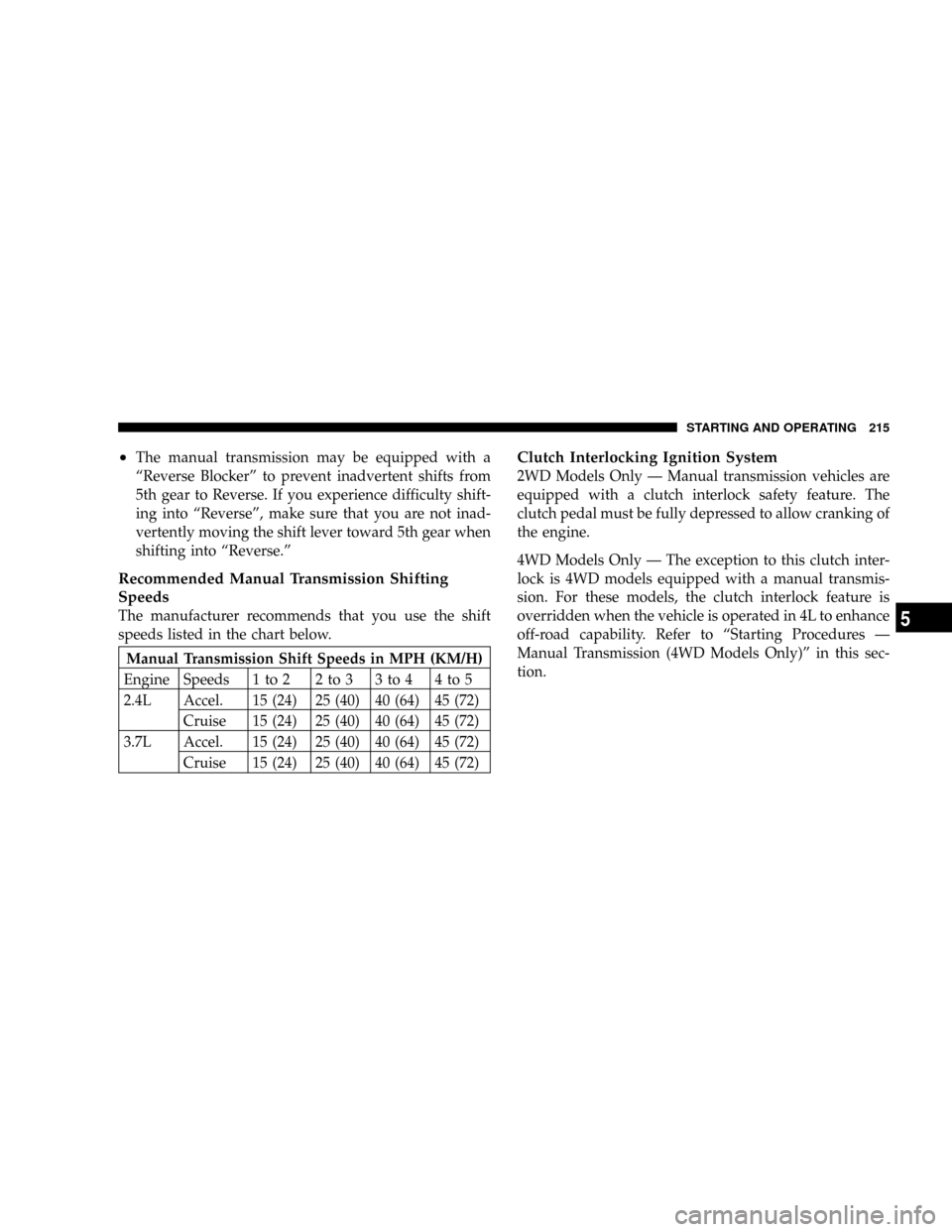2004 JEEP LIBERTY ECO mode
[x] Cancel search: ECO modePage 196 of 374

If you press the switch up or down twice it plays the
second track, three times, it will play the third, etc.
The button in the center of the left hand switch has no
function in this mode.
CD Player Ð 6 Disc in Cargo Area
Pressing the top of the switch once will go to the next
track on the CD. Pressing the bottom of the switch once
will go to the beginning of the current track or to the
beginning of the previous track if it is within one second
after the current track begins to play.
If you press the switch up or down twice it plays the
second track, three times, it will play the third, etc.
The button in the center of the left hand switch will cause
the CD changer to play the next available disc in the
6±disc magazine.
CASSETTE TAPE AND PLAYER MAINTENANCE
To keep the cassette tapes and player in good condition,
take the following precautions:
1. Do not use cassette tapes longer than C-90; otherwise,
sound quality and tape durability will be greatly dimin-
ished.
2. Keep the cassette tape in its case to protect from
slackness and dust when it is not in use.
3. Keep the cassette tape away from direct sunlight, heat
and magnetic fields such as the radio speakers.
4. Before inserting a tape, make sure that the label is
adhering flatly to the cassette.
5. A loose tape should be corrected before use. To rewind
a loose tape, insert the eraser end of a pencil into the tape
drive gear and twist the pencil in the required directions.
196 UNDERSTANDING YOUR INSTRUMENT PANEL
Page 202 of 374

Panel
Air flows through the outlets located in the instru-
ment panel. Slight airflow from the defrost outlet,
located at the base of the windshield, may be noticed.
Floor
Air flows through the floor outlets located under
the instrument panel and through the outlets lo-
cated in the rear of the center console. Slight airflow from
the defrost outlet, located at the base of the windshield,
may be noticed.
Mix
Air flows through the floor outlets, the outlets at
the base of the windshield, and the side window
demisters outlets.
Defrost
Air flows through the outlets at the base of the
windshield and through the side window demister
outlets.NOTE:To improve fuel economy, leave in Defrost only
when necessary.
Operating Tips
Fast Cool Down
For a fast cool down, turn the blower fan rotary knob to
the extreme clockwise position, turn the mode selector to
the panel position and drive with the windows open for
the first few minutes. Once the hot air has been expelled,
close the windows and turn the mode selector to Max
A/C-Recirculation. When a comfortable condition has
been reached, choose a mode position and adjust the
temperature control knob and blower speed as necessary
to maintain comfort. For high humidity conditions it may
be necessary to remain in the Max A/C-Recirculation
mode to maintain comfort.
202 UNDERSTANDING YOUR INSTRUMENT PANEL
Page 203 of 374

Window Fogging
In mild but rainy or humid weather, windows will fog on
the inside. To rapidly clear the fog off all the windows,
select the defrost mode, turn the temperature control
knob fully clockwise, and position the blower control to
its highest speed. Once the windshield has been cleared,
adjust the controls for your comfort.
On air conditioned vehicles, the compressor will operate
when in the Mix or Defrost modes and when the outside
temperature is approximately 30ÉF (-1ÉC) to provide
additional defrost/defog.
Summer Operation
Air conditioned vehicles must be protected with a high
quality anti-freeze coolant during summer to provide
proper corrosion protection and to raise the boiling point
of the coolant for protection against overheating. A 50%
concentration is recommended.
Winter Operation
When operating the system during the winter months,
make sure the air intake, located directly in front of the
windshield, is free of ice, slush, snow, or other obstruc-
tions.
REAR WINDOW FEATURES
Rear Window Wiper/Washer
A rotary ring switch on the control lever, located on the
right side of the steering column, controls operation of
the rear wiper/washer function. Rotating the center of
the switch up to the DEL (Delay) position or the ON
position will activate the wiper. Rotating the switch ring
beyond the ON or OFF position will activate the rear
washer. The wash pump will continue to operate as long
as the lever or ring is engaged. Upon release, the wipers
will cycle three times before returning to the set position.
UNDERSTANDING YOUR INSTRUMENT PANEL 203
4
Page 209 of 374

NTire Pressure Monitor System/4±Lo Mode
Ð If Equipped.......................256
NGeneral Information...................256
mTire Chains...........................257
mTire Rotation Recommendations............258
mFuel Requirements......................259
NReformulated Gasoline.................260
NGasoline/Oxygenate Blends..............260
NMMT In Gasoline.....................261
NSulfur In Gasoline.....................261NMaterials Added To Fuel................262
mFuel Tank Filler Cap (Gas Cap).............262
mTrailer Towing.........................264
NWarranty Requirements.................264
mRecreational Towing (Behind Motorhome, Etc.) . . 267
NTowing ± 2WD Models.................267
NTowing Ð 4WD Models................267
mSnow Plow...........................270
STARTING AND OPERATING 209
5
Page 210 of 374

STARTING PROCEDURES
Before starting your vehicle, adjust your seat, adjust both
inside and outside mirrors, and fasten your seat belts.
WARNING!
Do not leave children or animals inside parked
vehicles in hot weather. Interior heat build up may
cause serious injury or death.
Manual Transmission
Apply the parking brake, place the gearshift control lever
in N (Neutral) and depress the clutch pedal before
starting vehicle. This vehicle is equipped with a clutch
interlocking ignition system.4WD Models Only
In 4L mode, this vehicle will start regardless of whether
or not the clutch pedal is pressed to the floor. This feature
enhances off-road performance by allowing the vehicle to
start when in 4L without having to depress the clutch
pedal. The 4 LO MODE indicator light will illuminate
when the transfer case has been shifted into this mode.
Automatic Transmission
Start the engine with the selector lever in the N (Neutral)
or P (Park) position. Apply the brake before shifting to
any driving range.
Normal Starting
Normal starting of either a cold or a warm engine is
obtained without pumping or depressing the accelerator
pedal. Turn the key to the START position and release
when the engine starts. If the engine fails to start within
10 seconds, turn the key to the OFF position, wait 5
seconds, then repeat the normal starting procedure.
210 STARTING AND OPERATING
Page 215 of 374

²The manual transmission may be equipped with a
ªReverse Blockerº to prevent inadvertent shifts from
5th gear to Reverse. If you experience difficulty shift-
ing into ªReverseº, make sure that you are not inad-
vertently moving the shift lever toward 5th gear when
shifting into ªReverse.º
Recommended Manual Transmission Shifting
Speeds
The manufacturer recommends that you use the shift
speeds listed in the chart below.
Manual Transmission Shift Speeds in MPH (KM/H)
Engine Speeds 1 to 2 2 to 3 3 to 4 4 to 5
2.4L Accel. 15 (24) 25 (40) 40 (64) 45 (72)
Cruise 15 (24) 25 (40) 40 (64) 45 (72)
3.7L Accel. 15 (24) 25 (40) 40 (64) 45 (72)
Cruise 15 (24) 25 (40) 40 (64) 45 (72)
Clutch Interlocking Ignition System
2WD Models Only Ð Manual transmission vehicles are
equipped with a clutch interlock safety feature. The
clutch pedal must be fully depressed to allow cranking of
the engine.
4WD Models Only Ð The exception to this clutch inter-
lock is 4WD models equipped with a manual transmis-
sion. For these models, the clutch interlock feature is
overridden when the vehicle is operated in 4L to enhance
off-road capability. Refer to ªStarting Procedures Ð
Manual Transmission (4WD Models Only)º in this sec-
tion.
STARTING AND OPERATING 215
5
Page 220 of 374

NOTE:If the vehicle is started in cold outside tempera-
tures, shifts into Overdrive may be delayed. Normal
Overdrive and shifting operation will resume when the
temperature of the transmission reaches the appropriate
temperature. Refer to the ªNoteº under ªTorque Con-
verter Clutchº later in this section.
If the transmission temperature gets too hot, the trans-
mission may downshift out of Overdrive or engage
overdrive at higher vehicle speeds until the transmission
cools down. After cooldown, Overdrive will resume
normal operation.
2 (Second)
For moderate grades and to assist braking on dry pave-
ment or in mud and snow. Begins at a stop in low gear
with automatic upshift to 2nd gear. Will not shift to 3rd.1 (First)
For hard pulling at low speeds in mud, sand, snow, or on
steep grades. Begins and stays in low gear with no
upshift. Provides engine compression braking at low
speeds.
CAUTION!
²Never race the engine with the brakes on and the
vehicle in gear, and never hold the vehicle on an
incline without applying the brakes. These prac-
tices can cause overheating and damage to the
transmission.
²When ªrockingº a stuck vehicle by moving be-
tween ªFirstº and R (Reverse), do not spin the
wheels faster than 15 mph (24 km/h), or drivetrain
damage may result.
220 STARTING AND OPERATING
Page 221 of 374

Over Temperature Mode
The transmission electronics constantly monitor the
transmission oil temperature. If the transmission gets too
hot, the transmission will change the way it shifts to help
control the condition. This may result in a slightly
different feeling or response during normal operation in
D (Drive) position. If the transmission becomes hot
enough the TRANS TEMP warning light in the instru-
ment cluster will come on. After the transmission cools
down, it will return to normal operation.
Torque Converter Clutch
A feature designed to improve fuel economy has been
added to the automatic transmission of this vehicle. A
clutch within the torque converter engages automatically
at calibrated speeds. This may result in a slightly differ-
ent feeling or response during normal operation in high
gear. When the vehicle speed drops or during accelera-
tion, the clutch automatically and smoothly disengages.NOTE:
²The torque converter clutch will not engage until the
transmission fluid and engine coolant is warm (usu-
ally after 1±3 miles (1.6±4.8 km) of driving). Because
engine speed is higher when the torque converter
clutch is not engaged, it may seem as if the transmis-
sion is not shifting into ªOverdriveº when cold. This is
considered a normal condition. Pressing the ªO/D
OFFº switch will show that the transmission is able to
shift into and out of ªOverdrive.º
²If the vehicle has not been driven for several days, the
first few seconds of operation after shifting the trans-
mission into gear may seem sluggish. This is due to the
transmission fluid partially draining from the torque
converter into the transmission. This is considered a
normal condition and will not cause damage to the
transmission. The torque converter will refill within 5
seconds of shifting from P (Park) into any other gear
position.
STARTING AND OPERATING 221
5